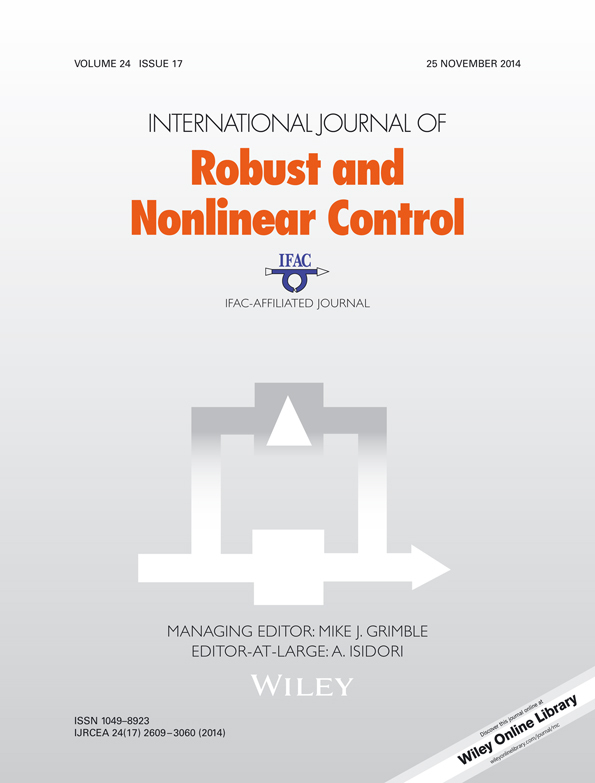Robust synchronization of linear dynamical networks with compensation of disturbances
Corresponding Author
Igor Furtat
Institute for Problems of Mechanical Engineering, Russian Academy of Sciences, 61 Bolshoy Ave V.O., Saint Petersburg, 199178 Russia
Saint Petersburg National Research University of Information Technologies, Mechanics and Optics, 49 Kronverkskiy Ave, Saint Petersburg, 197101 Russia
Correspondence to: Igor Furtat, Institute for Problems of Mechanical Engineering, Russian Academy of Sciences, 61 Bolshoy Ave V.O., Saint Petersburg, 199178, Russia.
E-mail: [email protected]
Search for more papers by this authorAlexander Fradkov
Institute for Problems of Mechanical Engineering, Russian Academy of Sciences, 61 Bolshoy Ave V.O., Saint Petersburg, 199178 Russia
Search for more papers by this authorAlexander Tsykunov
Astrakhan State Technical University, 16 Tatisheva Ave, Astrakhan, 414025 Russia
Search for more papers by this authorCorresponding Author
Igor Furtat
Institute for Problems of Mechanical Engineering, Russian Academy of Sciences, 61 Bolshoy Ave V.O., Saint Petersburg, 199178 Russia
Saint Petersburg National Research University of Information Technologies, Mechanics and Optics, 49 Kronverkskiy Ave, Saint Petersburg, 197101 Russia
Correspondence to: Igor Furtat, Institute for Problems of Mechanical Engineering, Russian Academy of Sciences, 61 Bolshoy Ave V.O., Saint Petersburg, 199178, Russia.
E-mail: [email protected]
Search for more papers by this authorAlexander Fradkov
Institute for Problems of Mechanical Engineering, Russian Academy of Sciences, 61 Bolshoy Ave V.O., Saint Petersburg, 199178 Russia
Search for more papers by this authorAlexander Tsykunov
Astrakhan State Technical University, 16 Tatisheva Ave, Astrakhan, 414025 Russia
Search for more papers by this authorSUMMARY
The problem of robust synchronization of a network of interconnected dynamical subsystems with a leader is considered. Each local subsystem of network is described by a linear time-varying parametrically and functionally uncertain differential equation. Only scalar inputs and outputs of local subsystems are supposed to be measured. A simple decentralized controller ensuring the tracking of the local subsystems by the leader under matching conditions is designed. The method is illustrated by an example, synchronization of the network with four nodes. Copyright © 2013 John Wiley & Sons, Ltd.
REFERENCES
- 1 Paszke W, Rogers E, Gałkowski K. H2 ∕ H ∞ output information-based disturbance attenuation for differential linear repetitive processes. International Journal of Robust and Nonlinear Control 2011; 21(17): 1981–1993.
- 2 Kanellakopoulos I, Kokotovic PV, Morse AS. Systematic design of adaptive controllers for feedback linearezable systems. IEEE Transactions On Automatic Control 1991; 36: 1241–1253.
- 3 Yu KT, Back J, Seo JH. Constructive algorithm for dynamic observer error linearization via integrators: single output case. International Journal of Robust and Nonlinear Control 2007; 17: 25–49.
- 4 Keller H. Non-linear observer design by transformation into a generalized observer canonical form. International Journal of Control 1987; 46(6): 1915–1930.
- 5 Atassi AN, Khalil HK. A separation principle for the stabilization of class of nonlinear systems. IEEE Transactions On Automatic Control 1999; 44(9): 1672–1687.
- 6 Nikiforov VO. Observers of external deterministic disturbances. II. Objects with unknown parameters. Automation and Remote Control 2003; 65(11): 1724–1732.
- 7 Bobtsov AA. Output control algorithm with the compensation of biased harmonic disturbances. Automation and Remote Control 2008; 69(8): 1289–1296.
- 8 Tsykunov AM. Robust control algorithms with compensation of bounded perturbations. Automation and Remote Control 2007; 71(7): 1213–1224.
- 9 Bukov VN, Ryabchenko VN, Zubov NE. Embedding and optimization of the linear systems. Automation and Remote Control 2002; 63(5): 702–712.
- 10 Lu J, Chen G. A time-varying complex dynamical network model and its controlled synchronization criteria. IEEE Transactions on Automatics Control 2005; 50(6): 841–846.
- 11 Ren W, Beard RW. Consensus seeking in multiagent systems under dynamically changing interaction topologies. IEEE Transactions On Automatatic Control 2005; 50(5): 655–661.
- 12 Yao J, Hill DJ, Guan ZH, Wang HO. Synchronization of complex dynamical networks with switching topology via adaptive control. Proceedings of the 45th IEEE Conference on Decision and Control, San Diego, CA, USA, 2006; 2819–2824.
- 13 Zhong WS, Dimirovski GM, Zhao J. Decentralized synchronization of an uncertain complex dynamical network. Proceedings of 2007 American Control Conference, New York, USA, 2007; 1437–1442.
- 14 Ioannou PA. Decentralized adaptive control of interconnected systems. IEEE Transactions on Automatic Control 1986; 31(4): 310–314.
- 15 Steur E, Nijmeijer H. Syncronization in network of diffusively time-delay coupled (semi-) passive systems. IEEE Transactions on Circuits and Systems – I: Regular Papers 2011; 58(6): 1358–1371.
- 16 Gavel DT, Siljak DD. Decentralized adaptive control: structural conditions for stability. IEEE Transactions on Automatic Control 1989; 34(4): 413–426.
- 17 Mirkin BM. Adaptive decentralized control with model coordination. Automation and Remote Control 1999; 60(1): 73–81.
- 18 Wang L, Jing Y, Kong Z, Dimirovski GM. Adaptive exponential synchronization of uncertain complex dynamical networks with delay coupling. NeuroQuantology: An International Journal of Neurology and Quantum Physics 2008; 6(4): 397–404.
- 19 Zhong W-S, Stefanovski JD, Dimirovski GM, Zhao J. Decentralized control and synchronization of time-varying complex dynamical networks. Kybernetika 2009; 45(1): 151–167.
- 20 Das A, Lewis FL. Distributed adaptive control for synchronization of unknown nonlinear networked systems. Automatica 2010; 46(12): 2014–2021.
- 21 Dzhunusov IA, Fradkov AL. Adaptive synchronization of a network of interconnected nonlinear Lur'e systems. Automation and Remote Control 2009; 70(7): 1190–1205.
- 22 Fradkov AL, Grigoriev G, Selivanov A. Decentralized adaptive controller for synchronization of dynamical networks with delays and bounded disturbances. Proceedings of 2011 IEEE Conference on Decision and Control and European Control Conference, Orlando, Florida, USA, 2011; 1110–1115.
- 23 Zhao J, Hill DJ, Liu T. Global bounded synchronization of general networks with non-identical nodes. IEEE Transactions On Automatatic Control 2005; 50(5): 655–661.
- 24 Li Z, Duan Z, Chen G, Huang L. Consensus of multiagent systems and synchronization of complex networks: a unified viewpoint. IEEE Transactions on Circuits and Systems – I: Regular Papers 2010; 57(1): 213–224.
- 25 Furtat IB. Robust synchronization of dynamical networks with compensation of disturbances. Automation and Remote Control 2011; 72(12): 2516–2526.
- 26 Athans MA, Falb PL. Optimal Control. McGraw-Hill: New York, 1966.
- 27 Brusin VA. A class of singularly perturbed adaptive systems. 1. Automation and Remote Control 1995; 54(4): 119–127.




